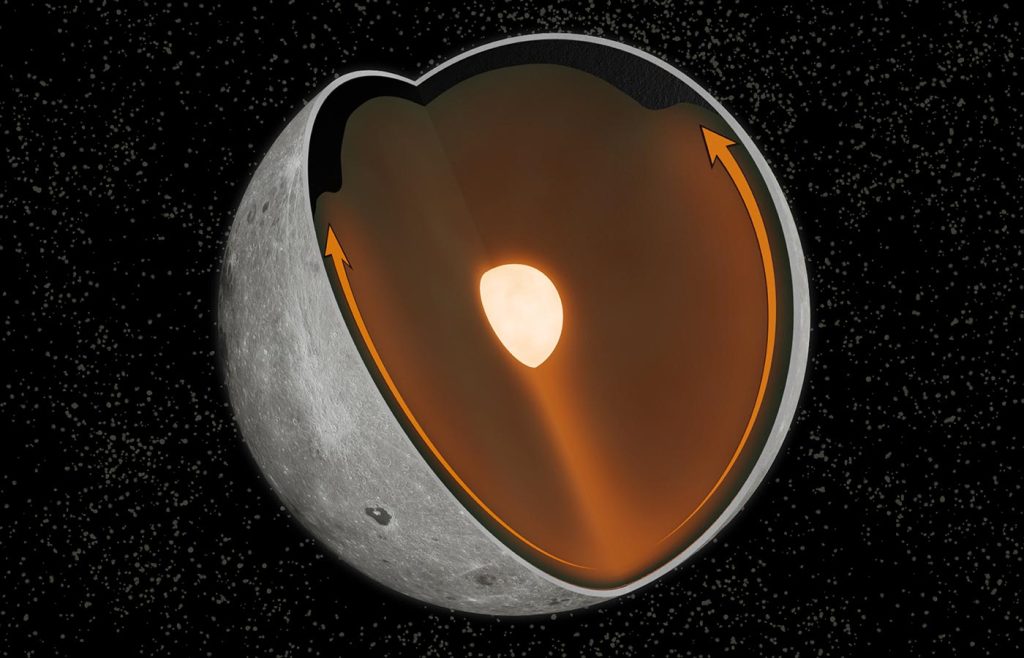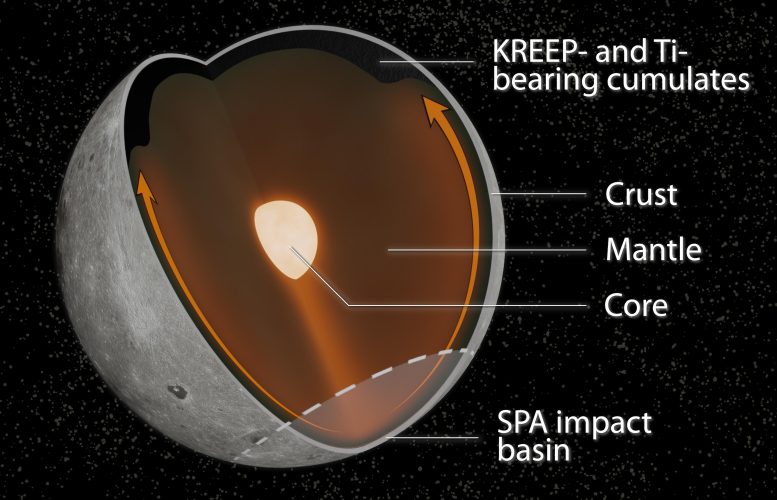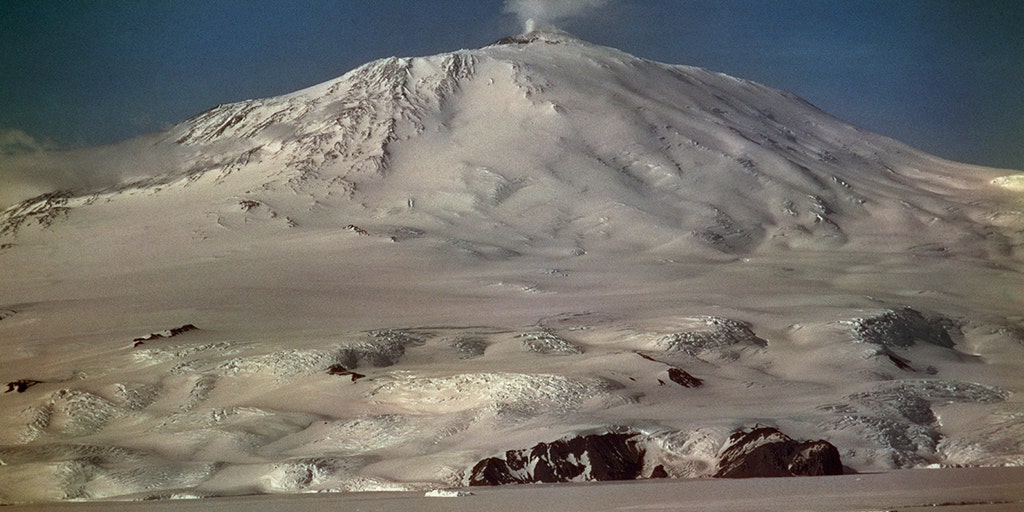
Egy új tanulmány kimutatta, hogy a Hold déli pólusán történt ősi ütközés megváltoztatta a holdköpeny konvekciós mintázatát, és a közeli oldalon lévő hőtermelő elemek csoportjára összpontosított. Ezek az elemek szerepet játszottak a Földről látható hatalmas holdpatkó kialakulásában. hitel: Matt Jones
Az új kutatások azt mutatják, hogy a Hold Déli-sark-Aitken-medencéjének becsapódása hogyan függ össze a Hold két oldala közötti összetételben és megjelenésben tapasztalható éles ellentéttel.
Az az arc, amelyet a Hold mutat a Földnek, nagyon másképp néz ki, mint az, amelyet a túlsó oldalán rejt. A közeli oldalt a holdbéli perzsák uralják – az ősi lávafolyamok hatalmas, sötét színű maradványai. Másrészt a kráterekkel teli túlsó oldalon gyakorlatilag hiányoznak a kiterjedt kanca jellemzők. A két oldal közötti nagy különbség oka a Hold egyik legmaradandóbb titka.
A kutatóknak most új magyarázatuk van a kétarcú holdra – ez a magyarázat a Hold déli pólusához közeli, évmilliárdokkal ezelőtti óriási becsapódáshoz kapcsolódik.
A Science Advances folyóiratban megjelent új tanulmány szerint a Hold óriás Déli-sark-Aitken-medencéjét (SPA) létrehozó becsapódás hatalmas hőcsóvát hozott volna létre a hold belsejében. Ez a csóva tartalmazott volna bizonyos anyagokat – ritkaföldfémek és hőtermelő elemek kombinációját -, valamint a közeli holdat. Az elemek ezen koncentrációja hozzájárulhatott ahhoz a vulkáni tevékenységhez, amely a közeli vulkáni síkságok létrejöttéhez vezetett.

A Hold közeli oldalán (balra) kiterjedt vulkáni lerakódások dominálnak, míg a túlsó oldalon (jobbra) sokkal kevesebb van. A két oldal közötti nagy különbség oka az örökhold rejtélye. Hitel: Brown Egyetem
„Tudjuk, hogy az olyan nagy hatások, mint amilyen az SPA-t alakították, sok hőt hoznak létre” – mondta Matt Jones, Ph.D. A Brown Egyetem kandidátusa és a tanulmány vezető szerzője. A kérdés az, hogy ez a hőmérséklet hogyan befolyásolja a Hold belső dinamikáját. Megmutatjuk, hogy az SPA kialakulásakor minden ésszerű körülmény között a közeli oldalon koncentrálja ezeket a hőtermelő elemeket. Úgy gondoljuk, hogy ez hozzájárult a köpeny megolvadásához, ami a felszínen látható lávafolyamokhoz vezetett. „
A tanulmány Jones és tanácsadója, Alexander Evans, a Brown Egyetem adjunktusa, valamint a Purdue Egyetem, az arizonai Hold- és Bolygótudományi Laboratórium, a Stanford Egyetem és a Stanford Egyetem kutatói közreműködésével jött létre.[{” attribute=””>NASA’s Jet Propulsion Laboratory.

A new study reveals that an ancient collision on the Moon’s south pole changed patterns of convection in the lunar mantle, concentrating a suite of heat-producing elements on the nearside. Those elements played a role in creating the vast lunar mare visible from Earth. Credit: Matt Jones
The differences between the near and far sides of the Moon were first revealed in the 1960s by the Soviet Luna missions and the U.S. Apollo program. While the differences in volcanic deposits are plain to see, future missions would reveal differences in the geochemical composition as well. The nearside is home to a compositional anomaly known as the Procellarum KREEP terrane (PKT) — a concentration of potassium (K), rare earth elements (REE), phosphorus (P), along with heat-producing elements like thorium. KREEP seems to be concentrated in and around Oceanus Procellarum, the largest of the nearside volcanic plains, but is sparse elsewhere on the Moon.
Some scientists have suspected a connection between the PKT and the nearside lava flows, but the question of why that suite of elements was concentrated on the nearside remained. This new study provides an explanation that is connected to the South Pole–Aitken basin, the second largest known impact crater in the solar system.
For the study, the researchers conducted computer simulations of how heat generated by a giant impact would alter patterns of convection in the Moon’s interior, and how that might redistribute KREEP material in the lunar mantle. KREEP is thought to represent the last part of the mantle to solidify after the Moon’s formation. As such, it likely formed the outermost layer of mantle, just beneath the lunar crust. Models of the lunar interior suggest that it should have been more or less evenly distributed beneath the surface. But this new model shows that the uniform distribution would be disrupted by the heat plume from the SPA impact.
According to the model, the KREEP material would have ridden the wave of heat emanating from the SPA impact zone like a surfer. As the heat plume spread beneath the Moon’s crust, that material was eventually delivered en masse to the nearside. The team ran simulations for a number of different impact scenarios, from dead-on hit to a glancing blow. While each produced differing heat patterns and mobilized KREEP to varying degrees, all created KREEP concentrations on the nearside, consistent with the PKT anomaly.
The researchers say the work provides a credible explanation for one of the Moon’s most enduring mysteries.
“How the PKT formed is arguably the most significant open question in lunar science,” Jones said. “And the South Pole–Aitken impact is one of the most significant events in lunar history. This work brings those two things together, and I think our results are really exciting.”
Refernece: “A South Pole–Aitken impact origin of the lunar compositional asymmetry” by Matt J. Jones, Alexander J. Evans, Brandon C. Johnson, Matthew B. Weller, Jeffrey C. Andrews-Hanna, Sonia M. Tikoo and James T. Kean, 8 April 2022, Science Advances.
DOI: 10.1126/sciadv.abm8475

„Utazási specialista. Tipikus közösségi média tudós. Az állatok barátja mindenhol. Szabadúszó zombinindzsa. Twitter-barát.”




More Stories
Ez az aktív vulkán az Antarktiszon valódi aranyport lövell ki
Az „ördögi üstökös” 12P/Pons-Brooks a Nap felé tart. Túléled?
Figyelemre méltó eredmények – Az új kutatások kimutatták, hogy a gerincvelő képes tanulni és memorizálni